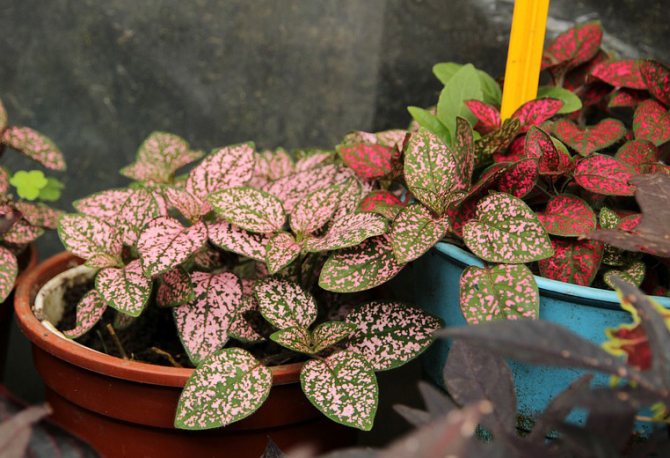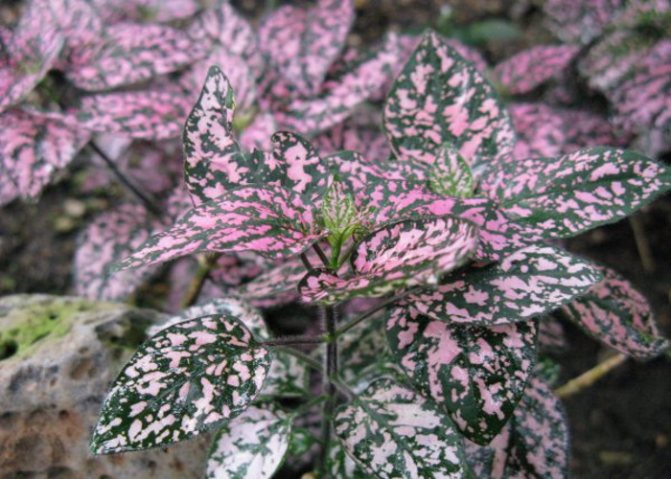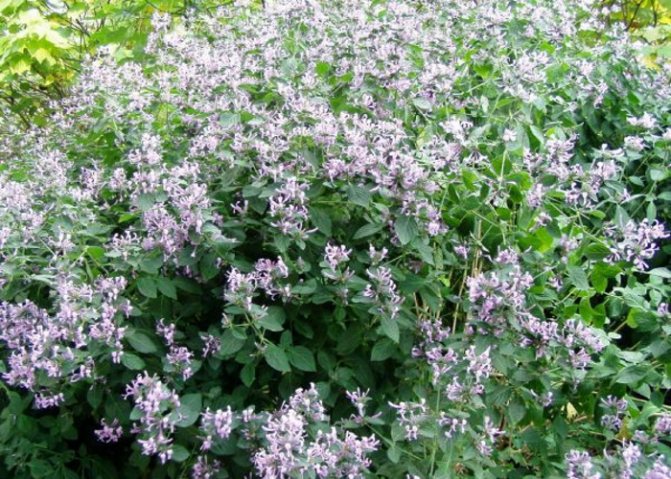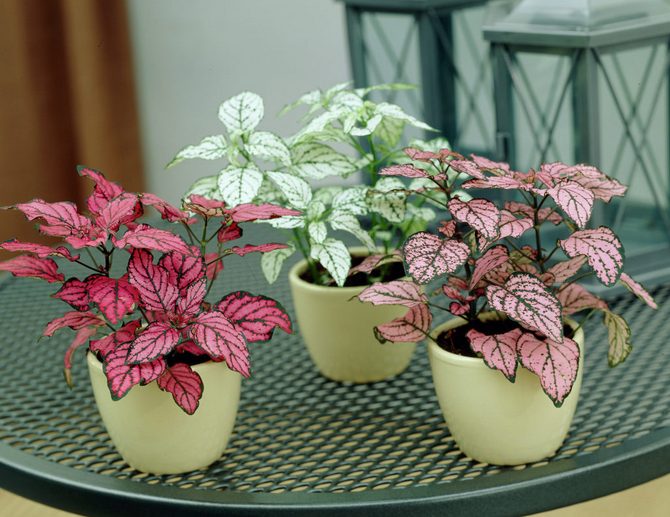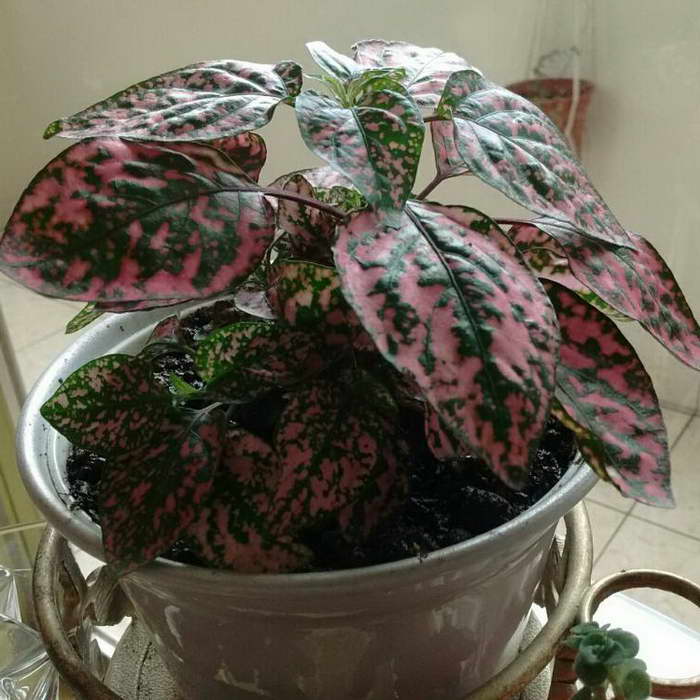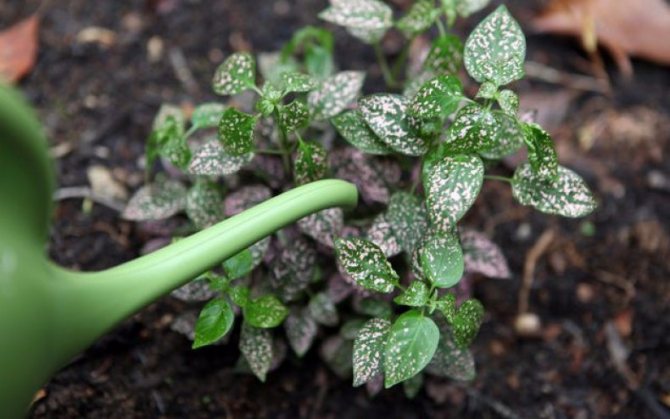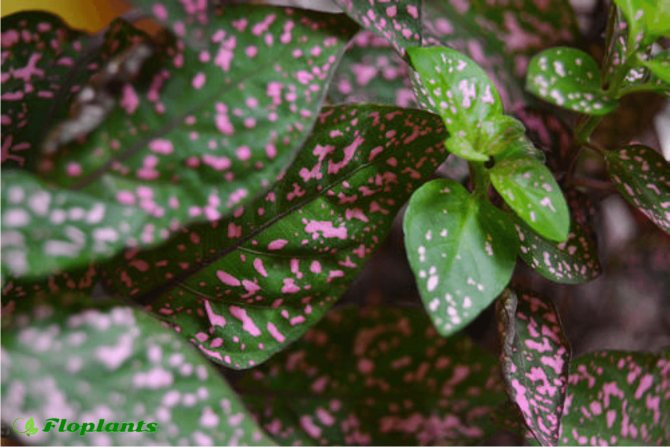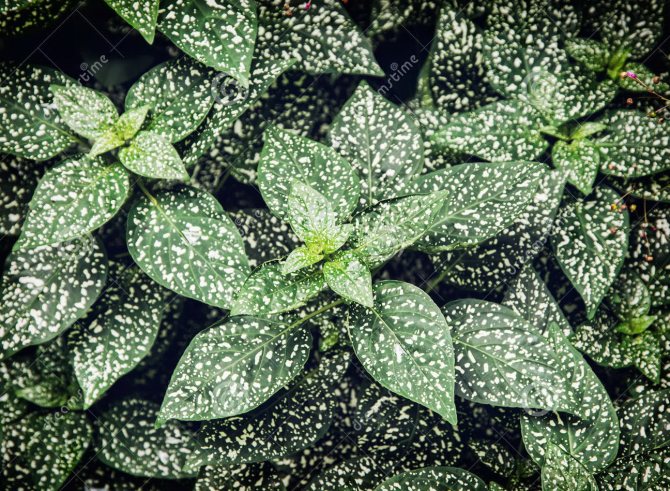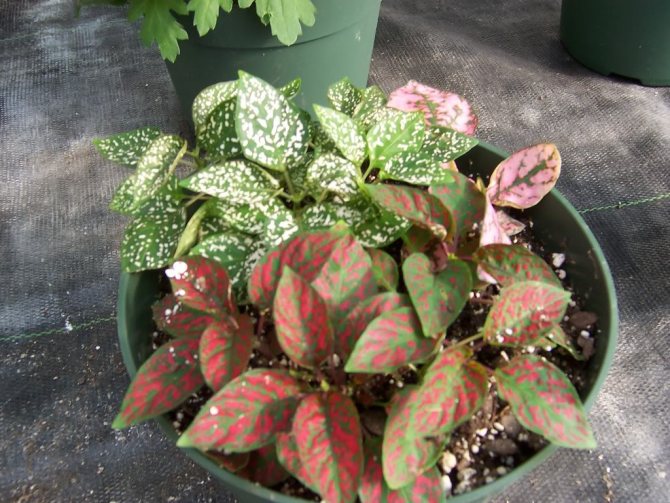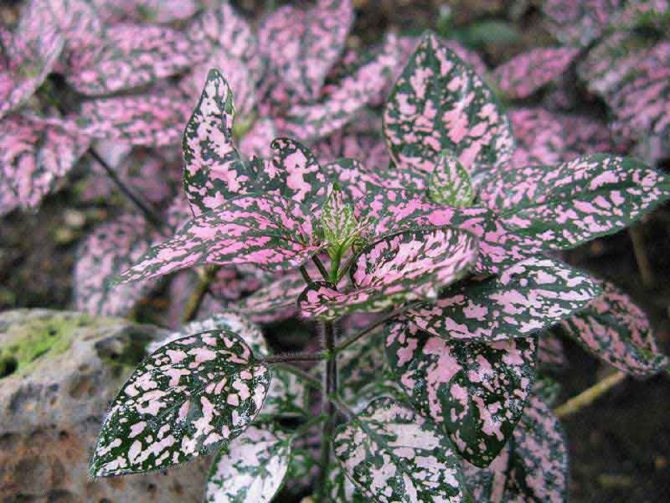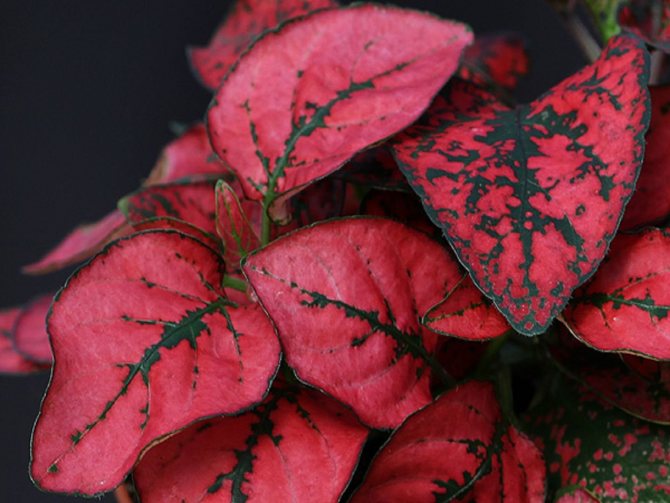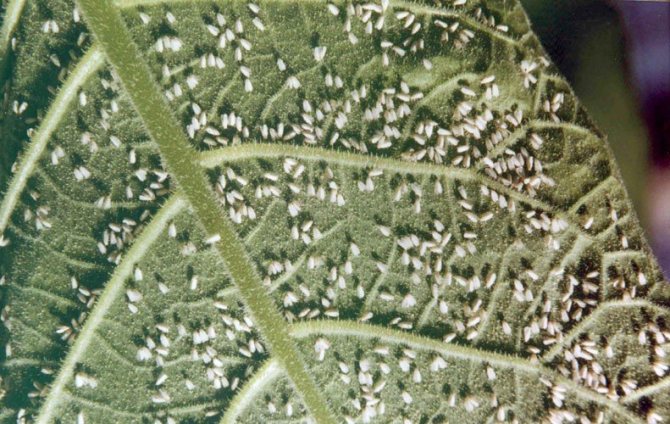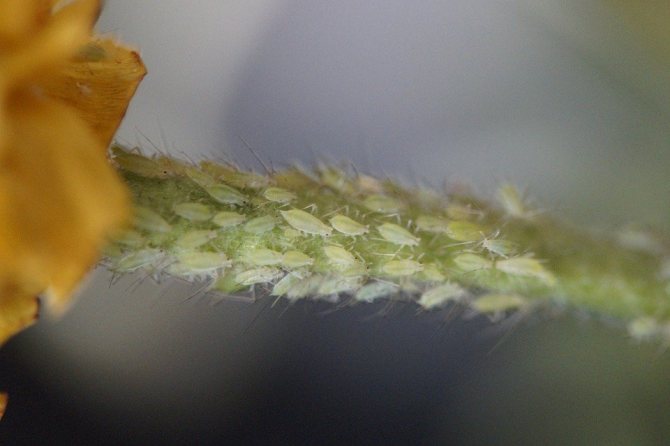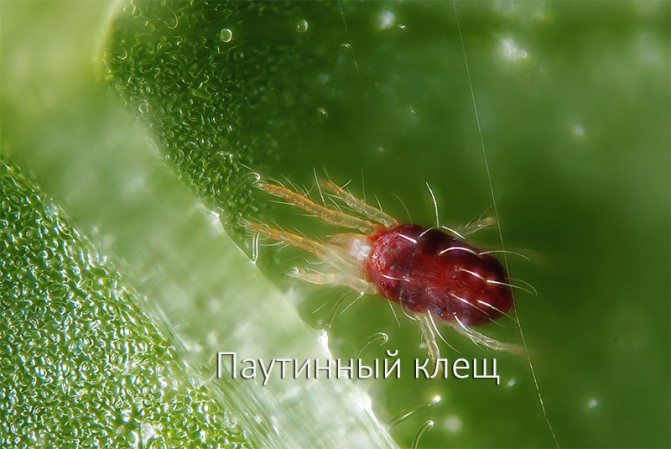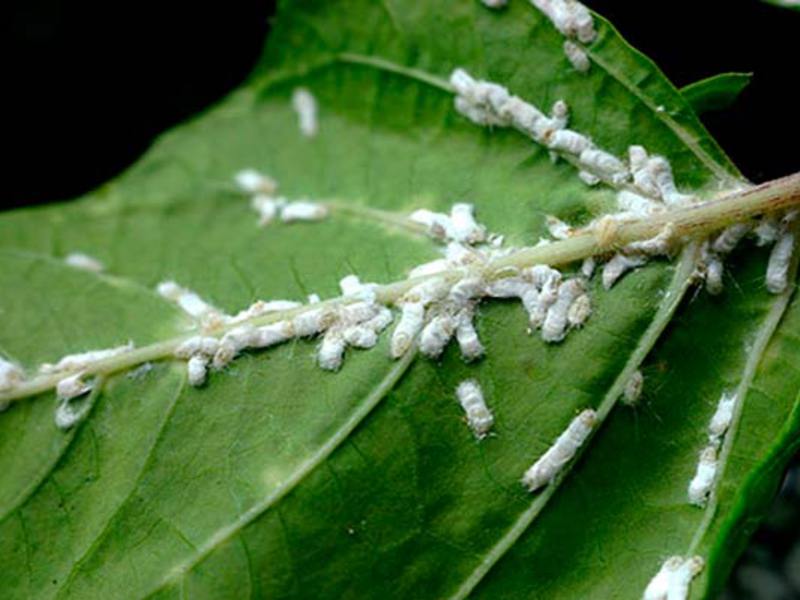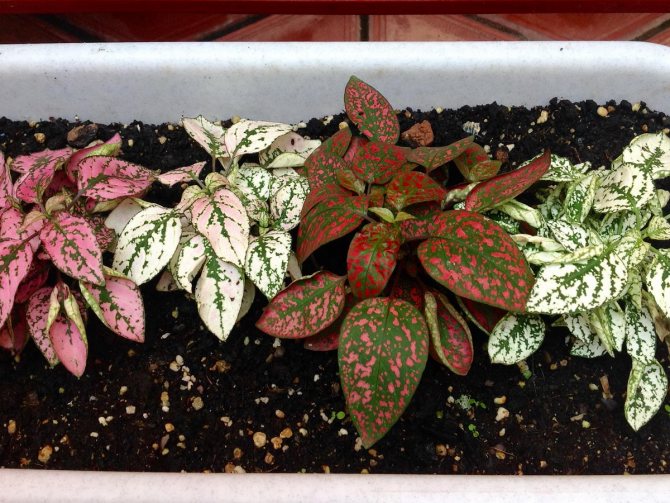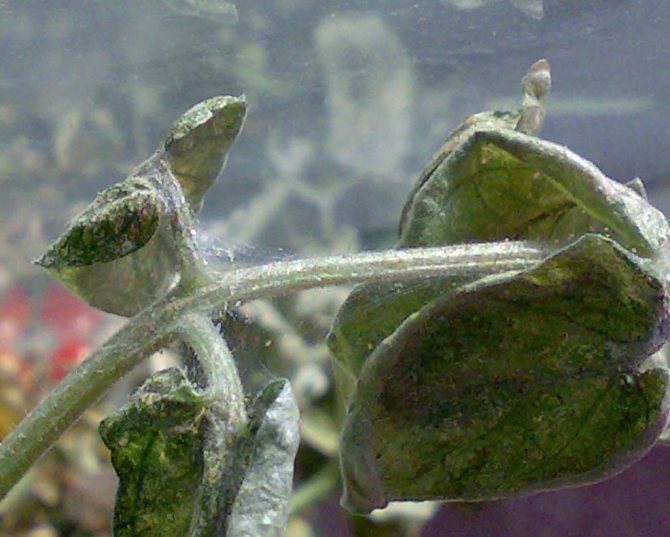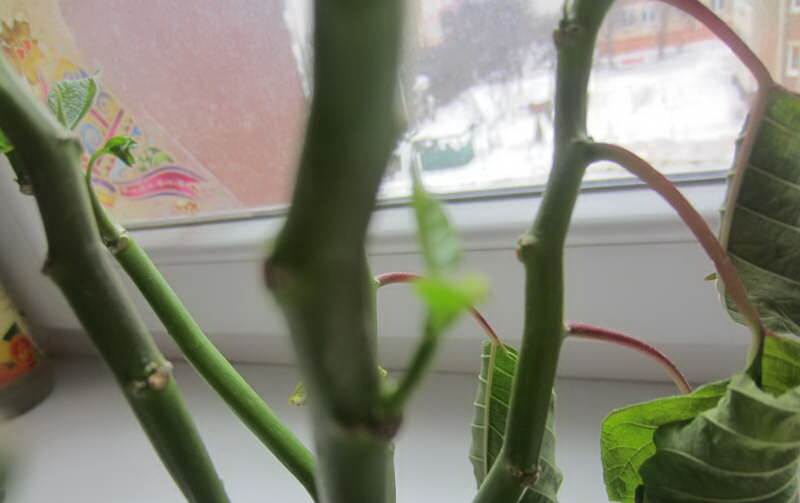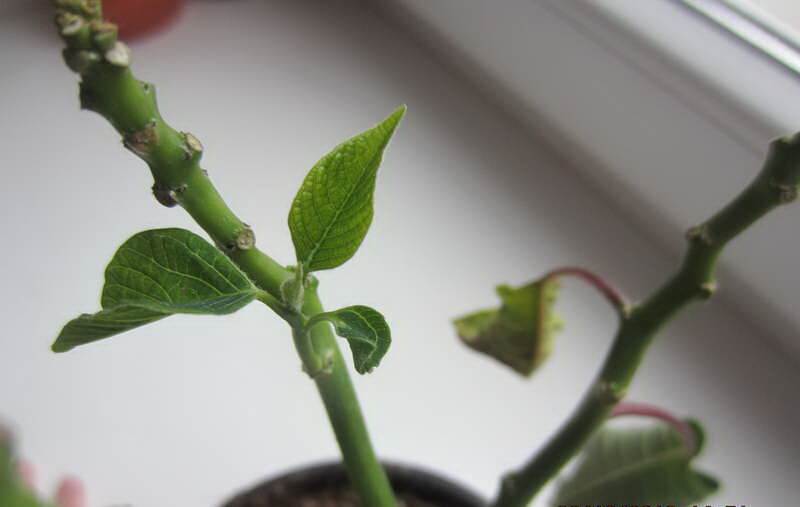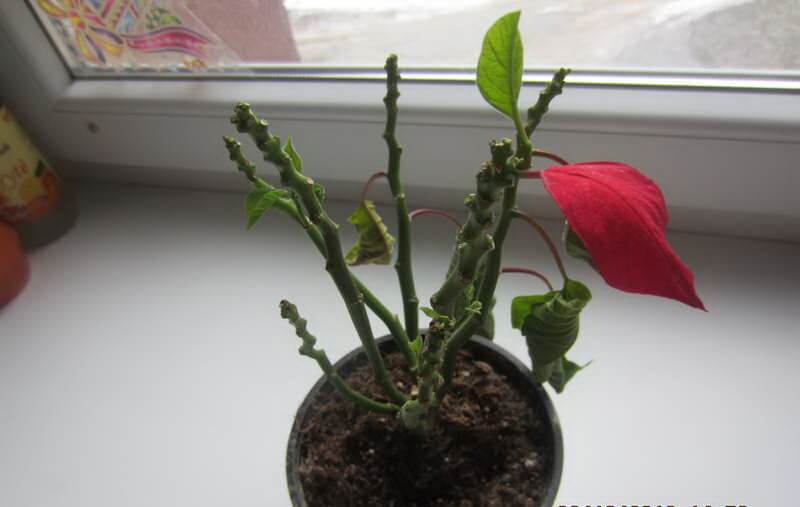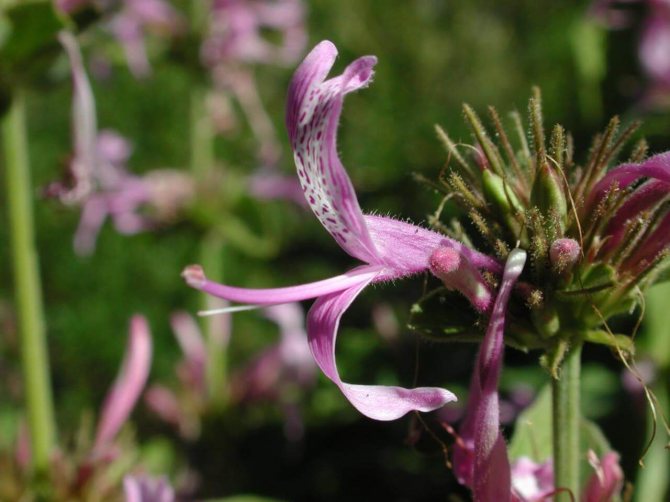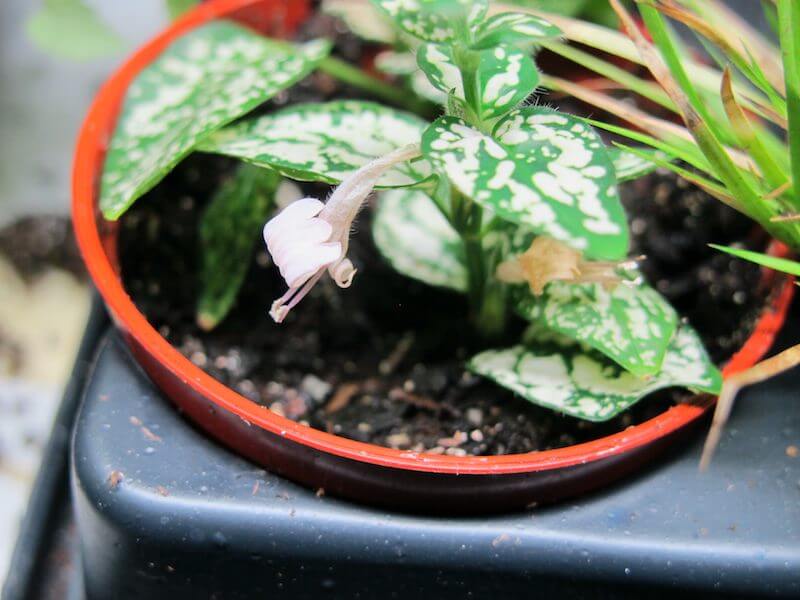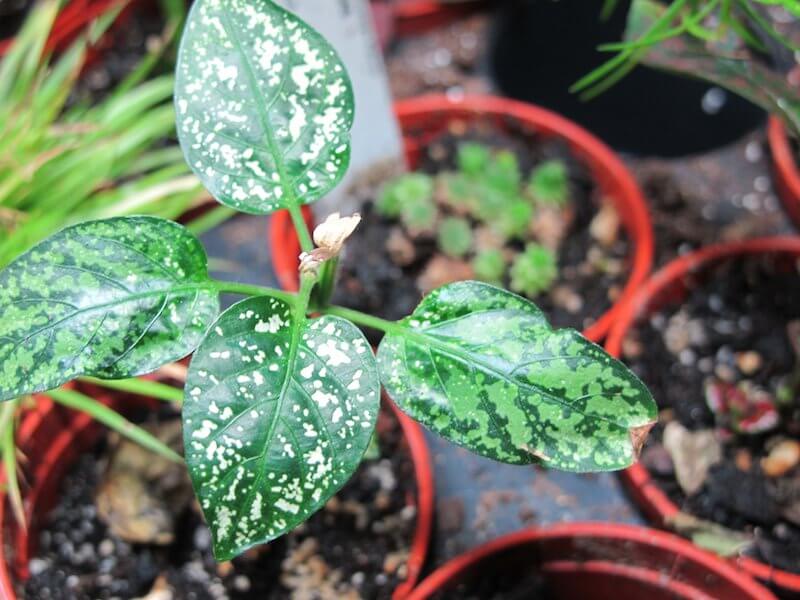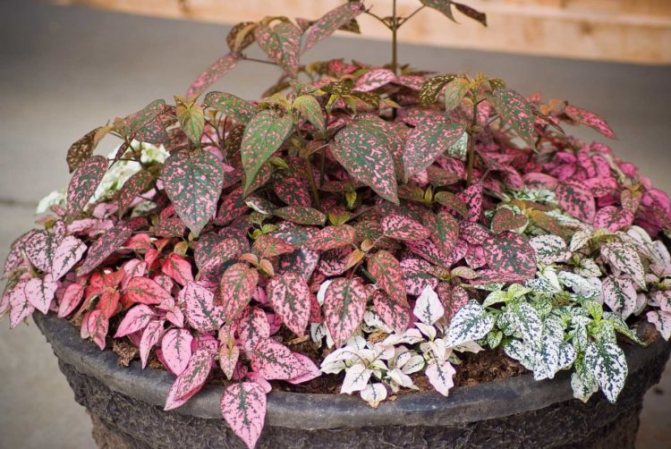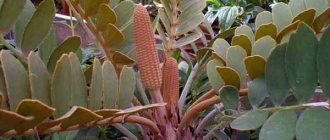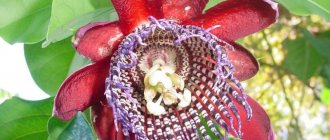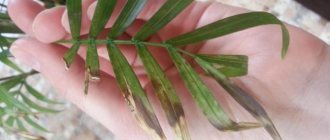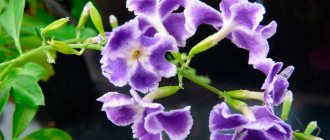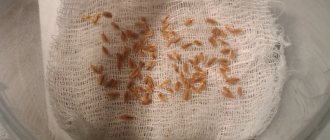The necessary conditions
Taking care of hypoesthesia at home is a snap.... This is an undemanding culture that takes root almost everywhere. The only condition for maintaining its decorative appearance is bright lighting. It is required to maintain the variegated coloring of the leaves.
Hypoestes is recommended to grow in southern, eastern and western rooms, but only direct sunlight is not allowed. In winter, you will have to take care of additional lighting using fluorescent lamps. If there is enough light, then the leaf plate will turn into an even green color. The temperature regime for the plant will be 20-25 degrees Celsius. In winter, these indicators can drop to 18-20 degrees Celsius, but not less. It is not worthwhile to specially create such races.
Hypoestes is a moisture-loving plant, so you will have to maintain high humidity in the room and spray the leaves with soft water. The pot can be placed in a wide pallet with damp expanded clay or moss... In this case, the bottom of the container should not come into contact with water.
Common species and varieties
Of the entire rich species set of hypoestesses, three species are "involved" in home floriculture.
Blood red hypoestes (Hypoestes sanguinolenta)
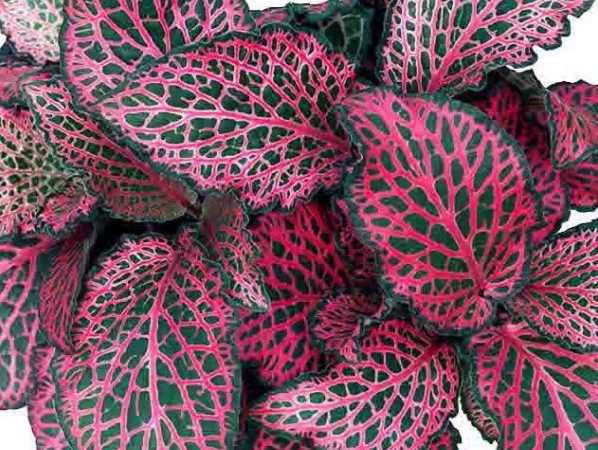
At home, in Madagascar, it looks like a low half-meter bush. The main background in the color of the leaves is dark green, with abundant splashes of red and pink spots, with purple veins. Leaves are ovoid, but noticeably tapering towards the ends, medium-sized (about 8 cm). It develops well a symmetrical, spherical crown. Flowers, unlike most species, also have a reddish tint, thus merging with the foliage.
It will not be an exaggeration to say that this species prevails in indoor floriculture. On its basis, several dozen varieties have been created, brought together into two groups: the so-called Confetti and Splash. All varieties differ, first of all, in the color of the leaves, and slightly in size.
Hypoestes phyllostachya


The main difference between the species is soft leaves (in other species they are more rigid), with a predominance of purple hues. His flowers are single, not collected in inflorescences, have a lavender color. Several varieties have also been created on the basis of the species, but much less than on the basis of blood red.
Hypoestes aristata


Much larger than the previous species, it is used most often in greenhouses and conservatories. Often, its bushes grow up to 1 meter. The leaves of the species are predominantly green, with a small reddish mosaic. But he can boast of rather large flowers: purple, pink, burgundy. It is for the sake of flowering that it is grown, which is a rarity in the world of hypoestes. Bred two varieties: "white" and "blue". The first pleases the owners with white flowers, the second with blue.
Proper watering


It is required to moisturize hypoesthesia abundantly and evenly. The soil should not dry out too much between waterings. Drain excess water from the sump 30 minutes after irrigation.
If the hypoesthetics are overdried, they will begin to shed the foliage and restore the crown for a long time.Use soft and settled water for irrigation.
Reduce moisture in autumn, and in winter, carry out 1-2 days after the top layer of the soil has dried.
Fertilizers for hypoesthesia
In the spring and summer, every 3-4 weeks, hypoesthesia needs fertilization. A solution of complex fertilizers with a high potassium content is used, this component will provide the best color of the leaves. You should not abuse nitrogen, a large amount of this substance lightens the colored specks on the foliage. The flower reacts well to organics, for example, to crushed mullein, which must be sprinkled on the soil in a pot.
To provide the plant with a decorative look, it is necessary to pinch the shoots from time to time. After pinching, good branching is ensured, with numerous, densely leafy shoots.
The subtleties of caring for a flower at home
Soil selection
Hypoestes prefers loose, nutritious, neutral or slightly acidic soil with a pH of 5-6. You can buy it or make it at home. To do this, take the following components (2: 1: 1: 1):
- leafy ground;
- humus;
- peat;
- river sand.
The stores already have a ready-made soil composition suitable for variegated indoor plants.... Before planting work, charmingly lay a drainage layer on the bottom of the tank, which will protect against stagnant water.
Fertilizer
Add nutrient composition once a month. Use commercially available preparations intended for variegated crops. They contain the right amount of potassium, which enhances the bright color of the leaves.
Transfer
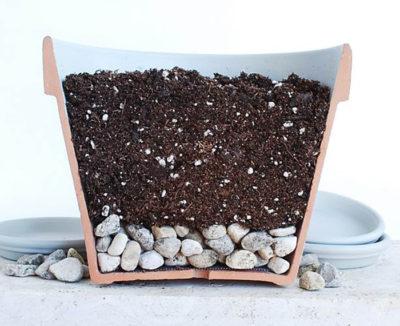

At home, the plant grows quickly and stretches, as a result of which its decorative effect is lost. So the transplant should be carried out every 3 years. Procedure:
- Water the soil abundantly the day before transplanting.
- Remove the plant together with an earthen clod. Do this carefully so as not to injure the root system.
- Place a drainage layer in a new pot, a new substrate.
- Transfer the flower to a new container and add the remaining substrate. Drizzle with a little water.
Hypoesthesia pests and diseases
Hypoesthesia diseases and their treatment
Moisture-loving hypoestes with constant waterlogging of the soil can get sick with root rot. You can save the plant from death only by cuttings: cut off healthy apical shoots from the affected flower and root them. To prevent hypoesthesia from getting sick, develop for it such an irrigation regime in which the soil will always be in a slightly damp state, but the roots will not be at risk of infection with rot. And with each subsequent transplant of hypoesthesia, do not forget to disinfect the soil in order to destroy the causative agents of fungal diseases.
Pests of hypoesthesia and the fight against them
If the indoor air is dry, hypoesthesia can affect scale insects, spider mites or thrips. With a small number of pests, it is enough to wash the flower under the shower and increase the humidity of the air, for example, by spraying, but before water procedures, the scale insects must be removed from the plant with a cotton swab dipped in alcohol: adults are covered with a shell that protects both them and the masonry from the effects of any drug. After showering, let the plants dry and treat them with a pest insecticide.
Keep in mind that spider mites are not insects, but arachnids, so it is useless to use insecticides against them. Insectoacaricides Aktellik and Fitoverm cope well with thrips, ticks and scale insects.
Features of outdoor cultivation
When growing a plant outdoors, it is important to observe the following guidelines:
- The landing site should be sunny, but protected from wind and direct rays.
- Water hypoesthesia 2 times a week. During the summer heat, water every day. Do this in the evening or morning.
- Apply top dressing all year round, since this plant does not have a dormant period. To do this, use mineral and organic compounds. Apply every 2 weeks. In autumn, reduce the frequency of fertilizers, but do not stop, since with a lack of nutrition, the edge of the leaf plate will begin to darken and dry out.
Photo gallery
Like numerous tropical representatives of the acanthus family, the herbaceous plant is a perennial, differs in inconspicuous flowers, opposite leaves have a narrow ovoid shape.
Reproduction
Seeds
The process of propagation of hypoesthesia by seeds is the simplest and most common... It goes like this:
- Collect the planting material in the fall on your own or purchase it in the store. Their germination capacity lasts up to 3 years.
- Planting should be carried out at the beginning of March, planting in small greenhouses with a sand-peat mixture.
- Pre-steam the soil composition. Soak the seeds for a day in a growth stimulator, and the next day evenly distribute over the soil surface.
- Shake them down with a thin layer of earth.
- Cover the greenhouse with glass for 2 weeks. Keep seedlings in a warm room and ventilate every day.
- After 7 days, seedlings are formed that require diffused lighting.
- 2 weeks after germination, pick and transplant into small containers.
Next is a visual video of how to grow hypoesthes using seeds:
Cuttings
With this method of reproduction, it is important to observe the following recommendations:
- Cuttings are carried out in spring or early summer.
- Cut off the apical cuttings without buds and with 3 adult leaves.
- Root in warm and soft water.
- During the first week, the first roots are formed at the base of the stem, therefore, the cutting is ready for planting in the ground.
- Cover the seedlings with a cap within 1 week after transplanting. Open it every day, gradually accustoming the plant to open air.
Description
More than 100 types of hypoesthesia are described in botanical encyclopedias. All of them have a bizarre leaf color. Colors and intricate patterns vary depending on the variety. Unlike Fittonia, which has multi-colored veins on the leaves, in hypoestesses pink, white, red shades can be on one plant in the form of spots, splashes or specks, and on another - as the main color.


But of the great variety presented in natural conditions, breeders managed to cultivate only a few species. Tropical plants with motley and cheerful colored leaves, the size of which does not exceed 10 cm, fell in love with flower growers and landscape designers.
Flowers do not have such decorative effect, they must be removed in a timely manner in order to preserve the plant. The bushes of hypoesthesia in indoor conditions reach a height of up to 50 cm. Outdoors they can grow even higher, but for decorativeness and the formation of a dense branching crown, you can cut off the tops.
Hypoesthesia shrubs are self-sufficient in beauty and attractiveness, but they easily get along with other plants in the home arboretum and perfectly dilute monochromatic greens.
Compositions with indoor ampelous plants or tall-stemmed palms look spectacular, and in the garden and on the personal plot motley "rugs" of hypoesthesia can make trees and shrubs even more decorative.
How does it bloom?
The dormant period can be shortened and flowering can be observed throughout the year by choosing different varieties. The buds are collected at the top of the bush. The flowers are tubular, they form in the axils and constantly replace each other. They are small, of a pale lilac shade, therefore they are lost against the background of bright leaves, but they make the plants elegant.
After flowering, the plant may die, so experienced flower growers remove the buds. If the seeds ripen and fall into the ground, they will sprout quickly.Then the old mother plant can be removed, and the pot with the fresh sprout left.
Signs and superstitions
It is believed that hypoesthes, grown at home, not only improves mood by its appearance alone, but also has an effect on the psychological climate. The plant is able to influence the development of human artistic talents, encourages creativity, teaches to feel and see beauty.
Even those people whose profession is not related to the sphere of culture, art or craft, acquire a craving for beauty. Many people start drawing or writing poetry.
But the vibrations of the flower should be contained. The planter with hypoesthesia is suitable for placing on a table in an office or in a home office.
It is not recommended to keep the plant in children's rooms and bedrooms.
Photo
Below you can see a photo of a hypoetesis growing at home and on the street.
You will find a detailed description of the varieties of hypoetesis in this material.
Soil and transplant
Hypoesthesia is transplanted annually in the spring. The plant can lose its visual appeal after 2-3 years, the lower part of the stems is exposed. For this reason, it is recommended to renew and replace old plants after one to two years with newly grown young bushes.
The soil is made up of two parts of leafy earth and one part of all subsequent components: torus, sand, humus. It is best to choose dishes for the plant that are not deep and wide with good drainage.
Possible difficulties
- In autumn and winter, overflow must be feared.
- If the soil is waterlogged, the leaves turn yellow and wither.
- The leaves wrinkle with excess light or very dry air.
- The plant is very rarely damaged by pests.
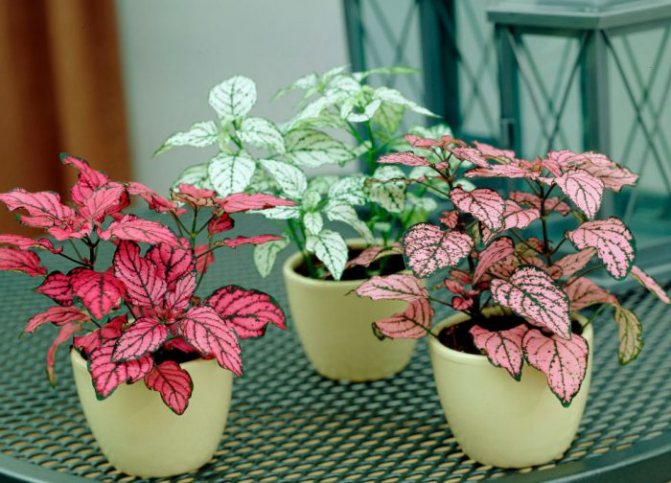

Hypoestes is an evergreen plant directly related to the acanthus family. In nature, it is found on the island of Madagascar, as well as in the tropical regions of South Africa.
Read also: Fat woman: diseases and pests, their symptoms and how to deal with them
The name of this plant is translated from Greek - "hypo" - under and "estia" - house. And this has a direct connection with the structure of the flowers, since the flowers are covered with bracts. This genus includes both herbaceous plants and shrubs. All of them are rather short and abundantly branching. Opposite leaves are ovoid and have jagged or even edges. They have a very spectacular color, for example, small spots are scattered over the surface of the green leaf, which can be of various shades, for example, pink, white or carmine red. Flowers are collected in semi-umbrellas or heads. Bracts fused together look like a bedspread, and near their base there are from 1 to 3 flowers.
Hypoestes - a miracle in polka dots


Hypoestes flower (Latin Hypoestes) is a perennial herb. Squat hypoestes has thin ovoid leaves with slightly pointed edges. Each variety surprises with its quirky, original, varied leaf color.
The flowers are tiny, lilac in color. The light lilac color of hypoesthesia flowers is not of decorative value, therefore many growers remove them at the bud stage. Connoisseurs of the beauty of this plant create a mix of different varieties, getting a unique composition on their windowsill.
How to take care of a handsome man
Caring for hypoesthesia is not difficult. You just need to take into account his tropical inclinations: love of warmth, high humidity of air and soil. And we must also remember that the variegation of the leaves must be maintained with top dressing. And do not forget about the formation of a bush.
As for the flowering of hypoesthesia, decide for yourself: do you want to risk the health of your motley green friend for the sake of not the most expressive flowers, or would you prefer to remove the buds.
How to water and fertilize
Quite large leaves of this plant evaporate a lot of moisture. Therefore, hypoestes loves soft and slightly warm water, and abundant watering in spring and summer.It is only important to maintain balance and not flood the plant. Excess moisture can cause root rot. Water the plant during active growth, when the topsoil dries out by 1–2 cm.
Reduce watering in the fall. And in winter, wait until the soil is dry for at least two days, and only then water. And stick to the rule: the lower the air temperature, the more modest the watering.
In spring and summer, fertilize hypoesthes twice a month with mineral and organic fertilizers, alternating them. Pay attention to the composition of the mineral complexes. Potassium is most useful for plant leaves. And nitrogen negatively affects their color. In winter, hypoesthesia also needs nutrition. But at this time, feed only once a month and reduce the dosage of the nutrient solution.
To bloom or not to bloom?
The beauty of hypoesthesia is not in the flowers, but in the bizarrely colored leaves. This plant blooms more than modestly: small pinkish or white inflorescences-pharynx appear one at a time or in small half-umbrellas on the stem. In winter, of course, it's nice to see even modest flowers, but is it worth allowing hypoesthesia to bloom?
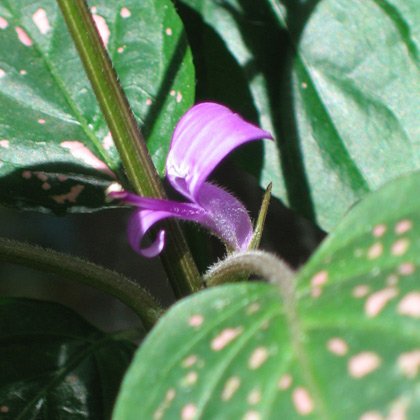

Many experienced florists recommend removing hypoesthesia buds.
Most hypoesthesia enthusiasts are inclined to believe that flowering is best prevented by cutting off the buds when they first appeared. The plant gives so much energy to flowering that it may die afterwards. Florists assure that faded hypoestes often passes into a dormant period, but then it does not always wake up. More often he dies.
Another side effect of flowering is that small seeds of hypoesthesia, while ripening, fly over rather considerable distances. They germinate easily, only this growth is difficult to control. Young growth is able to fill all neighboring pots with different flowers. So decide: bloom or not for your hypoesthesia?
Rest after flowering and bush formation
If you decide to allow your hypoesthesia to bloom, collect seeds in time and be sure to remove wilted inflorescences from the stem and from the pot. And when your flower has retired, try to help it, cut the stems, reduce watering and wait for young growth from the roots.
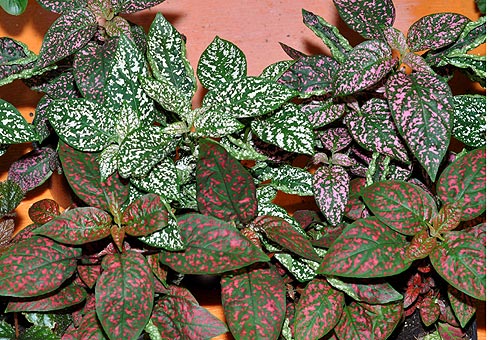

Hypoestes should be pinched regularly, as it is forced to branch
With age, the stem of hypoesthesia is exposed at the bottom. Therefore, young plants look more luxuriant and more decorative. The regular formation of the bush will help to preserve the beauty of the flower. Feel free to pinch the tops of the stems. After that, the plant branches better. If you haven't done shaping and the hypoesthesia is stretched out awkwardly, try a radical method. Cut the long stem close to the ground, continue to moisten the soil. Most likely, after a while new shoots will appear from the roots.
How Care Errors Manifest
Hypoestes is in good health. To make him sick, you need to "try". But often care errors worsen the appearance of the plant. How to restore hypoesthesia to its former beauty?
Table: Maintenance errors and their elimination
| Manifestation | Cause | Decision |
| The edges of the leaves dry out. | Excessively dry air. | Spray hypoesthes regularly. Humidify the air using all available methods. |
| Leaves fall. |
|
|
| The leaves began to turn yellow and lose elasticity. | Excess watering. | Adjust the watering mode. Wait for the topsoil to dry out. |
| The leaves turn pale and green, the variegated color disappears. The stems are extended. | Little light. | Place the plant in a lighter spot. Provide artificial lighting for fall and winter. |
| Brown spots appear on the leaves. | Sunburn. | Shade the plant at noon. |
| Spots on the leaves become faded, yellowness may appear. | Excess nitrogen in top dressing. | Change the top dressing. Fertilize with a high potassium complex. |
Possible growing problems
- Leaf plates wrinkle - too dry air or too much direct illumination.
- The specimen sheds foliage - placed in a draft, lack of watering, a sharp drop in temperature, or too cold content.
- The tips of the leaves dry out - it is necessary to increase the humidity of the room.
- Withering of leaves and their yellowing - the plant is overflowed, especially against the background of cold temperatures.
- The leaves lose their mottling, turn pale - there is little light or there is an excess of soil nitrogen.
- Brown spots on the leaves are the result of sunburn.
Despite the bright alarming color of the foliage, the plant is not at all poisonous.
Propagation of hypoesthesia using cuttings
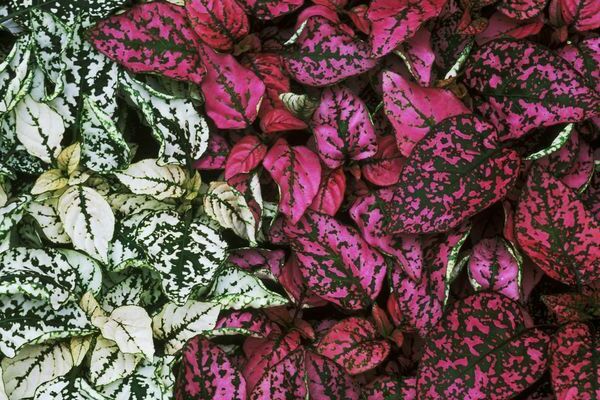

Quite worthy, hypoesthesia will reproduce by cuttings, in greenhouse conditions at temperatures from twenty-two to twenty-four degrees Celsius. After rooting the cuttings, they can be planted in individual pots as young bushes.
However, for young crops, a special mixture of soil is needed, which will consist of: peat soil, or humus of the earth, leafy soil, turf soil and coarse sand in an even amount. You can also root the cuttings with water, but then the constant temperature should be in the range from twenty-five to twenty-eight degrees Celsius.
General information about the origin
Hypoestes is a plant from the island of Madagascar, from where it spread very quickly along the belt of tropical latitudes around the world. Its invasive distribution is not always a reason for the joy of local residents, since it captures new territories and displaces some indigenous plant cultures. Some species of insects, for example, Costa Rican butterflies, laying eggs on its leaves, are not happy with it either. The plant turns out to be unsuitable for feeding the hatched caterpillars, because of which they die.
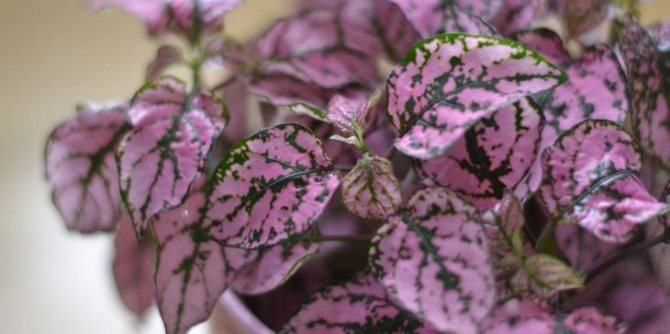

Growing hypoesthesia from seeds
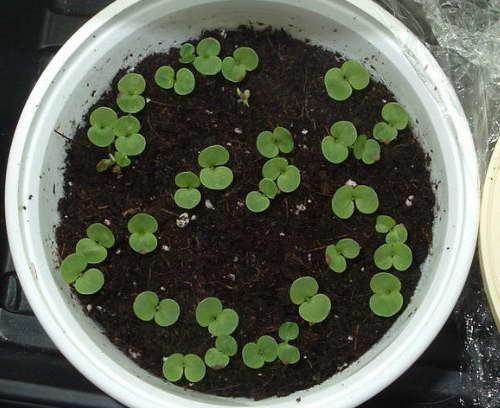

Hypoestes growing from seeds photo shoots
- Hypoesthesia seeds are sown in January-February.
- Prepare a container with a transparent lid and make drainage holes in the bottom.
- The land is best suited ready-made, for seedlings or decorative deciduous plants.
- Sow over the soil as rarely as possible, sprinkle lightly with earth on top.
- Pour from a spray bottle and cover the container with a lid.
- Further, maintain a temperature regime of 16-18 ° C, regularly ventilate and water from a spray bottle.
- Seeds sprout for a long time, sometimes after a couple of months.
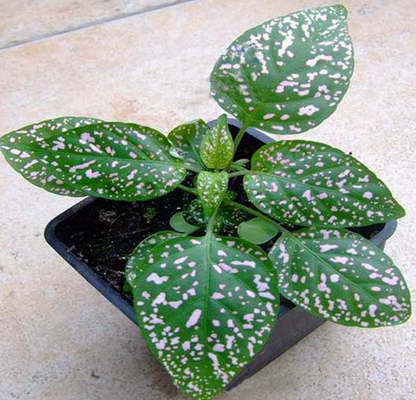

Hypoestes from seeds photo of finished seedlings
- The grown seedlings dive into separate cups and grow to full-fledged seedlings, which are then planted in pots separately or together with plants of a contrasting color.


